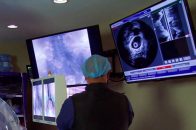Most post-angioplasty findings with optical coherence tomography (OCT) were not associated with clinical adverse events. Exceptions were small intra-stent area, and significant malapposition. Suboptimal findings after angioplasty are very common (almost expected), although their clinical implications are uncertain. This registry—recently published in JACC—was developed in an attempt to answer these questions. The analysis included a…
IVUS vs OCT to Guide PCI: Which Should We Choose?
Controlling stent expansion with optical coherence tomography (OCT) based on an external elastic membrane–based protocol for stent sizing resulted non-inferior to the control group which used intravascular ultrasound (IVUS) and superior the angiography only group. Based on these study outcomes and the prior outcomes, we should use IVUS imaging if available. There are no specific algorithms…
Intravascular Imaging: A Universal Approach for Angioplasty Optimization
Despite robust information supporting the use of intravascular imaging during coronary angioplasty, its use in clinical practice remains low. This paper proposes using an algorithm for decision-making throughout the procedure to promote increased intravascular imaging use. Regardless of the many technologies that have been incorporated into strut design struts and polymer type, the rate of…
AHA 2020 | In Most Cases, Imaging Can Determine What Causes MINOCA
Intravascular imaging with coronary optical coherence tomography (OCT) and magnetic resonance imaging allow for the identification of the cause of heart attack in 85% of women without coronary obstructions in angiography. Myocardial infarction with non-obstructive coronary arteries (MINOCA) affects women disproportionately and we have considered these events as “false positives” for far too long. The…
TCT 2020 | Using OCT to Detect Vulnerable Plaque even with Negative FFR
Optical coherence tomography (OCT) has proven useful in diabetic patients, even those with negative FFR. These findings make us rethink the ischemia and functional revascularization paradigm vs. the anatomical findings of vulnerable plaque. Diabetic patients with lesions that might be deferred base don FFR might benefit from OCT to find in these plaques certain risk…
AHA 2019 | COMPLETE: Complete Revascularization Is Superior since It Treats Other Vulnerable Plaque
This COMPLETE sub-study using optical coherence tomography (OCT) showed the prevalence of vulnerable lesions other than the culprit which should provide a physiopathological explanation of the benefit of complete revascularization observed in the original study. STEMI patients with multivessel disease will benefit from complete revascularization in terms of reduced cardiovascular death and repeat MI according…
Subintimal vs. Intraplaque Coronary Rechanneling. Do Results Vary?
Coronary rechanneling is difficult by nature, and there are several techniques for it aimed at improving technical success. Some of these strategies entail the subintimal crossing of the occluded segment, while others entail intraplaque crossing, without leaving the true lumen. However, there is scarce or no information on the results of both strategies. Researchers analyzed…






